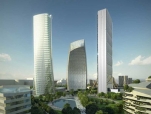In the Quest for Infinity

The tower designed by Arata Isozaki and Andrea Maffei as part of the redevelopment programme of the historical trade fair area in Milan commissioned by the company Citylife, is the first, with respect to those by Zaha Hadid and Daniel Libeskind, to start construction at the site. From its newly laid foundations (May, 2012), the skyscraper will reach a height of 207 metres in 2015, and will be the tallest in Italy.
The tower represents the future Business & Shopping District of CityLife in Milan (a subsidiary company of the Generali Group and in which Allianz has a shareholding), is progressing rather quickly. The construction of the complex, as well as many other large-scale projects in Milan, timed to the opening of Expo 2015. By January 2015, before the start of the World Expo, the entire complex will be completely ready. Thus, visitors can admire not only its exhibits, but also the new urban dominant. By 2015 it will reach a height of 207 metres, with 50 floors of offices, and will be the tallest skyscraper in Italy.
The foundation bed, which has just been built, is formed of a continuous block of concrete covering a total of 4,260 cubic metres and required 42 hours of continuous work. In the last few weeks 62 underpinning piles over 30 metres long were constructed out of reinforced concrete, and the foundation bed was reinforced with steel bars, with a total weight of around 1,200 tonnes. 630 m2 of formwork and 570 m2 of thermal insulation panels have already been laid. The dimensions of the base of the tower in the plan are 63 x 27 metres, while the sides of the building, which will rest on this base, measure 61.50 x 24 metres.
This is the state of the construction site, which has exceptional proportions, both physical and technological. The work programme provides for a series of actions that are closely related to each other: first the structures, then as the floors are gradually freed from the temporary scaffolding, the facades will be assembled. The skyscraper, comprised of a modular system that can in theory repeat indefinitely, has six office floors in each of the eight modules clad with a double- glazed glass skin. The vertical continuation of the modules, slightly convex, has been designed to create the concept of a tower without end.
The tower makes reference to the “Endless Tower” built in 1918 by the sculptor Rumeno Constantin Brancusi for the Targu Jiu public garden in Romania. Four slanted “struts” help to support the tower along the two main facades (reducing, among other things, the bulk of the load-bearing structures in the internal space) and act as one of the bracing systems. The side facades are partly glazed and display the structure of the panoramic elevators that lead to the various floors of the building.
The struts and the panoramic elevators aim to emphasize the futuristic concept of a building-machine. Through an open space entrance lobby on two levels, the tower is directly connected to the central square of CityLife and to the one below where the “Tre Torri” stop of the M5 line will be located. Service spaces and technical rooms will be located in the basement floors. The building, moreover, has an underground car park with spaces for 611 cars and 93 motorcycles.
The project has already obtained the LEED Gold Pre-certification, meeting the environmental sustainability requirements provided for by the Leed™ international standards. “In our archipelago of forms – explains Andrea Maffei – we found it interesting to develop the idea of a skyscraper without end, a sort of endless tower. We wanted to study a concept to be applied to the skyscraper, even before imagining its aesthetics. In the aspiration for maximum height, we chose to apply the concept of a modular system that could repeat indefinitely and seamlessly.”
CityLife Tower
Location: Milan, Italy
Application: office
Customer: CityLife srl, Milan, Italy
Contractor: Colombo Costruzioni, Milan, Italy
Architects: Arata Isozaki & Andrea Maffei
Built surface for the tower: 81.615 sq.m
Surface for parking areas (outdoors and underground): 44.485 sq.m.
Maximum building height: 207 m
Number of floors: 50
Number of office floors: 46
Number of work stations: 3864
Project implementation:
Schedule competition: 2003 (results: 2004) / Design: 2005-2011 / Start of construction: 2012 / Estimated completion:2015
Full version you can download here
 Materials provided by Andrea Maffei Architects
Materials provided by Andrea Maffei Architects


